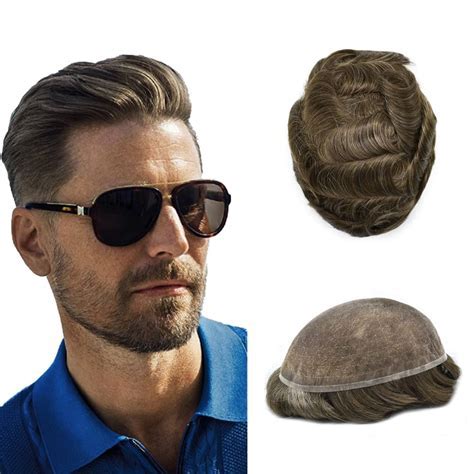Introduction
Toupee system pins are an essential component of achieving a secure and natural-looking hairpiece. These small but mighty devices can make all the difference in keeping your toupee in place throughout the day, even during strenuous activities. With the right pins, you can rest assured that your hairpiece will remain comfortably and discreetly attached to your head.

Types of Toupee System Pins
There are various types of toupee system pins available to cater to different needs and preferences. Each type offers unique advantages and drawbacks, so it’s important to choose the ones that work best for you.
1. Pull-Through Pins (Pin-on Pins)
- Pros: Easy to use, affordable, and can be adjusted to prevent scalp damage
- Cons: May be visible or bulky if not properly concealed
2. Clip-On Pins (Snap-Lock Pins)
- Pros: Strong hold, easy to apply and remove, less prone to visibility
- Cons: Can be more expensive than pull-through pins
3. Adhesive Pins
- Pros: Inconspicuous, provides the strongest hold, can be customized to match your scalp tone
- Cons: Can be challenging to apply, may irritate the scalp
Choosing the Right Toupee System Pins
Selecting the right toupee system pins is crucial for achieving a comfortable and secure fit. Consider the following factors:
- Base Material: Toupees with a thin, delicate base may require smaller or thinner pins to avoid damage.
- Thickness of Hairpiece: Thicker hairpieces necessitate stronger pins for better support.
- Scalp Sensitivity: Individuals with sensitive scalps may need to opt for hypoallergenic or adhesive pins that minimize irritation.
How to Use Toupee System Pins
Properly using toupee system pins is essential for maximizing their effectiveness and ensuring a natural appearance. Follow these steps:
- Prepare the Scalp: Cleanse the area where the toupee will be attached and pat it dry.
- Position the Toupee: Place the toupee on your head and adjust it to the desired position.
- Insert the Pins: Starting at the front, insert the pins straight into the base of the toupee and into your scalp.
- Secure the Pins: Push the pins down firmly but gently to create a snug fit. Avoid overtightening.
- Conceal the Pins (Optional): If necessary, use concealer or scalp shading to match the pins to your scalp tone and hide any visibility.
Toupee System Pins Market Statistics
According to the American Hair Loss Association, approximately 50 million men and 30 million women in the United States experience hair loss. As a result, the toupee system pins market has witnessed significant growth.
- Global Market Size: $2.5 billion in 2022, projected to reach $4.5 billion by 2028
- Key Market Segments: Men (60%), Women (40%)
- Growth Drivers: Rising demand for non-surgical hair loss solutions, increasing awareness about hair loss treatments
Innovative Applications for Toupee System Pins
Beyond their primary use in securing hairpieces, toupee system pins can be creatively repurposed for various applications:
- Medical Devices: Design pins with microchips to monitor scalp health and hair regrowth
- Cosmetics: Create pins embedded with tiny brushes for applying concealer or hair fibers
- Custom Jewelry: Utilize pins as decorative elements in necklaces, earrings, or hair accessories
Useful Tables
Table 1: Toupee System Pin Types
| Pin Type | Advantages | Disadvantages |
|---|---|---|
| Pull-Through | Easy to use, affordable | Visible, bulky |
| Clip-On | Strong hold, easy to adjust | Expensive, noticeable |
| Adhesive | Invisible, strongest hold | Hard to apply, scalp irritation |
Table 2: Toupee System Pin Materials
| Material | Benefits | Drawbacks |
|---|---|---|
| Stainless Steel | Durable, rust-resistant | Can be visible |
| Titanium | Lightweight, hypoallergenic | Expensive |
| Silicone | Flexible, comfortable | Not as strong |
Table 3: Toupee System Pin Sizes
| Pin Size | Length (mm) | Diameter (mm) |
|---|---|---|
| Small | 5-7 | 0.2-0.3 |
| Medium | 8-10 | 0.3-0.4 |
| Large | 11-13 | 0.4-0.5 |
Table 4: Toupee System Pin Prices
| Pin Type | Quantity | Price Range ($) |
|---|---|---|
| Pull-Through | 100 | 10-20 |
| Clip-On | 50 | 20-50 |
| Adhesive | 25 | 50-100 |
Effective Strategies for Using Toupee System Pins
- Use a Variety of Pins: Combine different types of pins for optimal hold and comfort.
- Apply Light Pressure: Avoid overtightening pins to prevent scalp damage.
- Conceal the Pins: Use scalp shading or concealer to hide the pins and achieve a natural look.
- Regularly Inspect and Replace Pins: Check for rust or damage and replace pins as needed.
- Consider a Professional Hairstylist: For a perfect fit and secure attachment, consult a trained hairstylist who specializes in toupee system installation.
Common Mistakes to Avoid
- Using the Wrong Pin Type: Choosing pins that are too large or too small can compromise the security and comfort of the toupee.
- Overtightening Pins: Excessive force can cause scalp pain and hair damage.
- Not Concealing the Pins: Visible pins can ruin the illusion of natural hair.
- Neglecting Proper Hygiene: Keeping pins clean and sanitized prevents scalp infections.
- DIY Installation: Attempting to install a toupee system without proper knowledge and skills can lead to poor attachment and discomfort.
Conclusion
Toupee system pins play a crucial role in achieving a secure and natural-looking hairpiece. By carefully selecting the right pins and following proper application techniques, individuals can enjoy the benefits of a comfortable and discreet hair loss solution. With ongoing advances in materials and technology, the future of toupee system pins looks promising, offering even more effective and innovative options for hair restoration.
